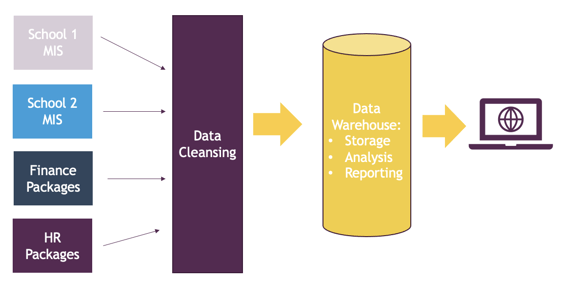MATs and schools are not short of data, but are you finding that you are drowning in all that data? So much so that you can’t see the wood for the trees. Making informed decisions to improve learning, teaching and business outcomes is challenging to say the least.
When there is lots of disparate data across a Trust, it can take a lot of time and human resource to consolidate it to help inform decision making. This burden can take leaders’ focus away from what the school is actually there for – educating our children.
What is the ideal Data Management position for a MAT?
In a perfect world, schools within a Trust would be collecting, storing and analysing their data in exactly the same way. They would be using the same MIS or a way of connecting all the data from multiple sources. MAT leaders desire a way to easily present data visually to different audiences. As such, making Data Management and Reporting easier by reducing time taken to manage the data and allowing for true comparisons to be made, resulting in timely and effective decision making that has a positive impact on outcomes.
To truly use data to raise Trust performance, we believe that you should follow these six factors:
- Consistent data quality – allowing you to compare apples with apples and benchmark not only within the Trust but against national data sets. Resulting in better quality insight.
- Timely access - being able to act on insight at an early point when it will have greater impact.
- Regular routines - benefit from automation making data processing a regular task.
- Pattern spotting – by bringing the data together in one place, it is easier to spot patterns.
- Decision making is data and insight led – benefiting individual pupils, schools and the Trust as a whole.
- Evidence of impact – use data to show what impact decisions/actions have had on performance.
We speak with MAT leaders regularly and they say that they would like to be more ‘data-driven’ and they desire a way to be able to explore their data in a methodical way that facilitates decisions with reduced uncertainty to deliver continued improvement. So, how can they do this? Using a Data Warehouse is how.
What is a Data Warehouse?
A data warehouse is a type of data management system that is designed to enable and support business intelligence (BI) activities, especially analytics…….A data warehouse centralizes and consolidates large amounts of data from multiple sources. Its analytical capabilities allow organizations to derive valuable business insights from their data to improve decision-making. Over time, it builds a historical record that can be invaluable to data scientists and business analysts. Because of these capabilities, a data warehouse can be considered an organization’s “single source of truth.”
Oracle
As this definition says, a Data Warehouse takes multiple data sources and puts it into a central place. There is also a step in-between, where the data is cleansed to ensure accuracy.

Why use a Data Warehouse?
As well as the obvious benefit of becoming a single source of truth, there are six key benefits of using a data warehouse:
- Transform data into knowledge – therefore be able to make evidence-based decisions
- Boost efficiency – have data at your fingertips in consistent formats and reduce manual data analysis.
- Streamline flow of data – timely access to data that is pulled in automatically with less manual intervention.
- Be more strategic – basis of good business intelligence approaches; learning from patterns, trends and comparisons to steer MATs strategic direction e.g. allocating resources for increased productivity.
- Actionable insights - improve the teaching and learning experiences for both teachers and pupils; the visual formats of dashboards and charts makes it quicker to see what those actions should be.
- Empower decisions – gives trustees/leaders confidence that decisions are wise and will allow the Trust and its’ schools to function smarter, meet goals and optimise its’ full capabilities.
Why are more Trusts not using a Data Warehouse?
The simple answer is cost and knowledge. Creating and maintaining an efficient data warehouse takes a lot of technical knowledge and can cost anything from tens of thousands to hundreds of thousands depending on the complexity.
Once created, that’s not it. As well as on-going maintenance, if you make any tweaks (small or large) to your MIS, you will need to carry out updates to the data warehouse which requires time and expertise. Your focus is on education and achieving learning outcomes for your students, rather than on maintaining a data warehouse.
Given these challenges, how can a MAT still achieve the benefits that a data warehouse can bring?
We speak with MAT leaders regularly and they say that they would like to be more ‘data-driven’ and achieve the benefits that can come from that. They desire a way to be able to explore their data in a methodical way that facilitates decisions with reduced uncertainty to deliver continued improvement. But not all data is equally valuable and unless it is maintained in a Data Warehouse that can facilitate interpretation and reporting, informed decision making is difficult.
For those reasons, here at Novatia, we developed Questa, which is a data warehouse built specifically for MATs and combines the functionality of a data warehouse with the accessible front end ‘window’ on the data. It brings together key school data from various sources, in a visual format, allowing you to quickly see what is happening, and analyse it further. With a few clicks, you can dig deeper, focusing your analysis on relevant areas that can have an impact on your Trust performance, such as attainment, behaviour, finance or HR.
Questa creates an overarching Trust-level view as well as comparisons amongst member schools. By bringing in areas such as finance and HR into the Data Warehouse, you can also make correlations between learning outcomes and the business aspects of your MAT. The way it has been designed focuses on building a better decision experience for users as well as introducing visual design and analytical rigour.
Bringing your data into the Questa Data Warehouse will put you on the journey to making data-driven decisions that improves the overall performance of your Trust without the costs and technical knowledge required to ‘go it’ alone.
If you’d like to find out more about Questa and see how it can work for you and your Trust, then book a free demo with one of our Questa experts.
Alternatively, if you would like to have a chat about Questa and your Trust, please email us on info@novatia.com or call the team 01962 832632
Watch the Webinar
Like to learn more? Jan Harrison has made a FREE webinar ''Data Warehouse – how it can help your MAT function smarter." For further details and the recording click here.
Let us help you ...
Alternatively, if you would like further help and would like to speak directly to us, get in touch either by phone on 01962 832632 or by email on info@myquesta.co.uk. We’d be happy to provide guidance.

Visit: www.novatia.com/home-questa Email: info@myquesta.co.uk Call: 01962 832632







